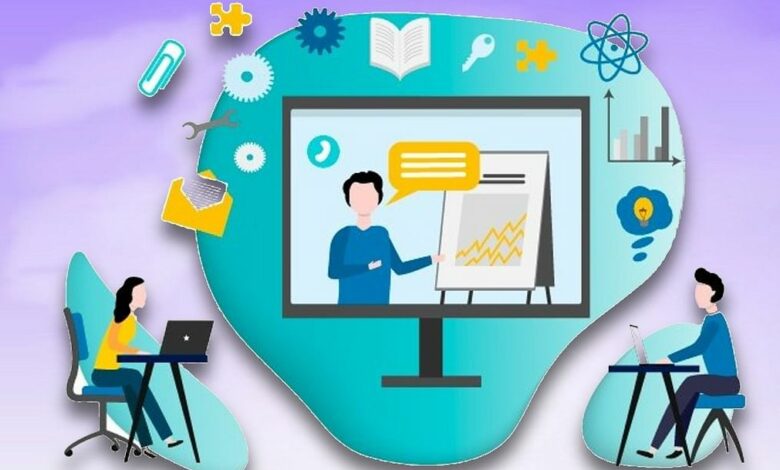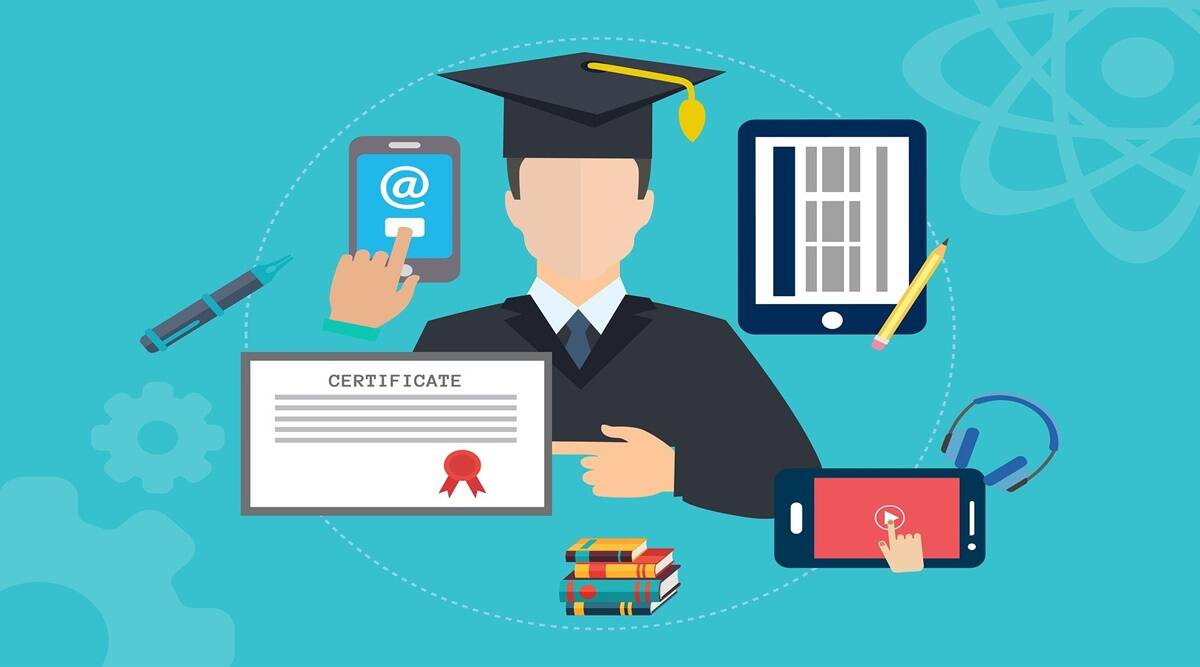Budget 2022: Establishment Of A Digital University For Online Learning

Budget 2022: Establishment Of A Digital University For Online Learning
On Tuesday, India’s Finance Minister, Nirmala Sitharaman, announced the establishment of a Digital University for online learning, dubbed ‘DESH-Stack platform,’ based on a hub-and-spoke approach. The institution will be established in conjunction with several Indian universities.
This will be available in various Indian languages and formats for information and communication technology (ICT). “Digital instructors” will create high-quality e-content in all spoken languages for transmission via the internet, mobile phones, television, and radio.
The purpose of this project, which is open to all citizens of the country, is to help people improve their skills, upskill, or reskill. It will also offer API-based trustworthy skill certifications, payment, and discovery layers to help people locate appropriate employment and start businesses.
A National Skill Qualification Framework (NSQF) will be matched with the industry dynamic to encourage continual skilling channels, sustainability, and employability.
She went on to say that a TV channel called ‘e-Vidya’ will be launched to provide supplemental education to children in grades 1 to 12, particularly in rural regions, to compensate for the loss of learning caused by the COVID-19 pandemic.
“We recognise the necessity for additional instruction and to develop a resilient structure for education delivery,” Sitharaman added. PM eVIDYA’s ‘one class-one TV channel’ initiative will be expanded from 12 to 200 TV channels for this reason. All states will be able to provide extra education in regional languages for grades 1 through 12 as a result of this.”
In addition, in 2022-23, 750 virtual laboratories in science and mathematics and 75 skilling e-labs for simulated learning settings will be built to improve critical thinking abilities and provide space for creativity.
She further stated that relevant ‘Drone-as-a-Service’ skilling courses will be put out in the Indian Institutes of Technology (IITs) to encourage ‘Drone Shakti’ among businesses.
“The education budget for 2022 correctly emphasises upskilling and digital learning. The budget addressed systemic concerns in education and ensured that all children had equal access to school. The budget has also coincided with the opening of schools, which is critical in reversing student learning loss. The government must act to address the requirements of a young generation that is optimistic about the future. Overall, it has boosted the education sector, which would help the country advance,” said Ms Shweta Sastri, MD of the Canadian International School in Bengaluru.
The education sector received a budget of 93,224 crore last year, accounting for 2.67 per cent of the central government’s expected budget for 2021-22.
According to the Economic Survey 2022, the government has also extended the National Apprenticeship Training Scheme for the next five years with an outlay of 3054 crore, which will help nearly 9 lakh students be employable through apprenticeship.

What is Digital University, and how does it work?
To all candidates, the concept of a digital university is a boon. With this novel concept, all of the university details may be obtained with a few keystrokes on their computer or laptop, which would typically be a time-consuming effort.
Another patience-testing activity is writing to all universities that an applicant has short-listed and waiting for responses and forms from them. Finally, students do not need to be physically present on the University’s campus to take university courses or receive quality education (technical and non-technical), nor do they need to pay the usual sky-high fees that every institute charges (other than the admission and examination fees which would be very meagre).
Students may say goodbye to mind-numbing tasks thanks to the notion of Digital University. This idea also eases the burden on students’ wallets by requiring only the purchase of a terminal and a broadband connection to connect to the University where the courses are held.
It will be a distributed network system, or NGN, with several access modes based on the authorities, such as university personnel, college administration, and the end-user, i.e. the student.
Education and technology are inextricably linked. Bringing education, particularly vocational education, to rural India will soon be more accessible thanks to mobile phones. The cell phone is a tremendous leveller in society when it comes to education dissemination,” says one expert. This will provide a new paradigm for disseminating knowledge to remote parts of the country and will aid in the bridging of divides through the use of wireless and mobile technology.
As mobile wireless network technology becomes more widely used, it is becoming increasingly important to educate people about this new mode of communication.
The digital university would allow students to learn through digital ways. It will prevent the need for physical classrooms in favour of virtual ones. “For this aim, the PM e-Vidya programme of one class — one TV channel will be enlarged from 12 to 400 TV channels,” Sitharaman stated. According to the Finance Minister, the university will be established on a ‘hub and spoke’ basis. “Our networked hub and spoke approach will be used to build cutting-edge ICT competence at the university,” she stated.
This university’s courses will be provided in a variety of Indian languages and ICT forms. She went on to say that as a result, all states will be able to provide extra education in regional languages to students in grades 1 through 12.
“Our country’s greatest public universities and institutes will collaborate as a hub and spoke network,” she stated.

What is the purpose of establishing a Digital University?
Children in the country have been unable to attend school due to Covid-19. Children, particularly in rural areas and those from Scheduled Castes
(SC) and Scheduled Tribes (ST) and other underprivileged sectors have lost nearly two years of formal education due to the pandemic-induced school closures, according to Sitharaman.
She also stated that most of the children affected were from government schools. The Centre recognises the necessity for supplemental instruction and developing a resilient education delivery system.

Benefits of digital learning
1. Lectures will be recorded
Some of your classes will be recorded, which is one of the major advantages of digital learning. This means that if you forget something or later realise you don’t understand something, you may go back and revisit the class to acquire the answers you need.
You can always ask your teacher for help if you’re having trouble, but tackling a problem on your own can be a terrific experience!
2. Resources that are available at all times
You won’t have to worry about the library or the lab being closed if you choose to study in the evenings or can’t sleep and need to get some additional studying done after hours with digital learning.
You’ll be able to access your learning materials at any time, and you’ll be able to conduct science experiments from the comfort of your own home, thanks to advanced tools like lab simulations.
3. Connected learning
Another advantage of digital learning is that you will become a member of a linked community. Applications like Zoom and Microsoft Teams can connect you with your classmates and help you discover the answers you need quickly if you need assistance with something.
And while your teachers will still have a schedule of classes to teach throughout the day, you won’t have to wait until your next lesson with them to ask them any questions.
You’ll have the freedom to communicate at times during the day that is convenient for you, even though they won’t always be able to respond right away.
Finally, even if you are physically separated from your classmates, technology such as video conferencing allows you to communicate with your new pals effortlessly.
4. Self-directed study
Self-directed learning is a crucial component of higher education. It refers to time spent learning outside of class when an instructor is not supervising you.
This period is crucial because it allows you to recognise your strengths and places where you might need to put in more effort.
When you still have a lot of touch with your lecturers while studying online, there will be times when you’ll have to make a conscious decision to study and decide what to focus on.
Taking control of your education in this way may be quite empowering, and it can give you a sense of self-confidence that will help you do even better. Self-directed learning is a big part of university education, so it’s a terrific way to prepare for your degree.
5. A variety of options
We now have access to a multitude of technology, which is especially true when it comes to online learning – you’ll be able to mix and match the programmes and software you use with various individuals and for different purposes.
Even if your teacher sometimes uses Zoom to broadcast lectures, you’ll be able to experiment with different collaboration methods with your students when working on a group project, whether it’s Zoom, Slack, Microsoft Teams, or even WhatsApp!
6. Written language skills
You might improve your written language skills by using digital learning. When you’re studying online, you’ll probably use instant messaging programmes to communicate with people, so you won’t be able to rely on hand gestures or facial signals to help you communicate.
That means you’ll learn how to write clearly and understandably, which will be helpful to practise for all of the essays you’ll be writing.
7. A working knowledge of technology
Because of our hyper-connected world, an increasing number of organisations are going global, with overseas headquarters and remote workers in various nations.
As flying across the world for a meeting isn’t always feasible, many firms are turning to online connectivity solutions to establish virtual conference rooms — similar to the tools you use to join online seminars or get together with your classmates to discuss assignments.
When you graduate, you’ll have a lot of expertise with software that some working professionals are still learning, which will assist you in making the transition from school to work.
8. Track progress
Not only does digital learning assist you in identifying your strengths and shortcomings, but it also allows your teachers to monitor your development. They’ll have an easy-to-access online record of all your efforts and will be able to keep track of your participation.
Your teacher, for example, will be able to notice if you attend all of your seminars but do not participate in some of them. That could be because you’re having trouble with the content, and they’ll be able to help you out. They might even notice there’s an issue before you do!
9. Fewer emissions
Like many youngsters, you may be attempting to limit your “carbon footprint,” or the activities you engage in that contribute to CO2 emissions and may have a detrimental impact on the global environment.
Because you won’t have to travel to your classes every day if you study online, you’ll be able to cut down on the amount of trips you take. You’ll also have extra time to yourself, as your longest travel between the couch and your peaceful study location can be between the two. These are fantastic advantages of online learning!
10. It’s fun.
Finally, studying online is incredibly successful since it is enjoyable! You may even discover that you have absorbed a lot of information without even noticing it because you were too busy having fun!

Disadvantages of digital learning
1. Information of high quality
Although kids have access to a wealth of information thanks to the internet, there is a significant drawback. Users, especially students, can be “totally satisfied” or “disappointed” with what’s supplied in the digital domain, as is the case with many internet-based applications or services, according to an essay pro review. Students may come upon inaccurate, incorrect, or even fraudulent content.
2. It necessitates prior training
Students must understand how to use new technology properly to make the best use. This necessitates prior computer science and information and communication technology skills (ICT). And it’s still unclear if the school or the families should provide such training. The truth is that computer science is covered in school, but this isn’t always enough. As a result, parents should make an effort in this area.
3. School investment
It is not inexpensive to provide a classroom with computer resources and mobile devices. It necessitates a financial investment by the educational facility in the purchase of the equipment and its upkeep. Computers, tablets, and smartphones are sensitive gadgets, and the chance of them breaking increases enormously when they pass through multiple hands.
4. Inequality in society
Although everyone may have access to the internet, the truth is that many households still cannot afford it. As a result, it can create social disparities within the classroom and among students. As a result, it is recommended that teachers give technology lessons in the school so that pupils without proper equipment are not marginalised.
5. They can create dependency
Students may become mentally lazy as a result of their usage of technology. These technologies make it easier to complete tasks or exercises with a single click, discouraging students from delving deeper into what they’re learning. According to Apple, 85% of mobile users believe their gadgets are vital in their daily lives. It’s an excellent example of how addictive tablets and laptops can be. As a result, schools must teach students how to use technological tools responsibly or become unproductive.
In the case of grammar activities, for example, the autocorrect application for smart devices inhibits pupils from recognising their errors and instead relies on the suggestions provided by such tools. The same is true for calculation jobs when children and teenagers lose their numerical capacity to do operations without using calculators.
They become reliant on technology, which can slow down their learning or lead to obtaining inaccurate or misleading information from websites due to a lack of pedagogical support.

Digital university: Some hail ‘futuristic’ move, others say no ‘roadmap.’
The Union Budget drew mixed reactions from educationists, despite an overall increase in financial allocation for the education sector and a focus on digital modes of learning — from the expansion of the PM e-VIDYA initiative to the proposal to launch a “digital university” and the development of e-content in all Indian languages.
While the emphasis on digital learning and providing regional language content was appreciated, many questioned whether the statement would be merely lip service because no “concrete path” was provided.
Dr Dishan Kamdar, the vice-chancellor of FLAME University, described the choice to create a digital university as a “futuristic decision” that will assist a massive number of students from around the country by making world-class education accessible. “The aim to expand ‘One Class One TV Channel’ from 12 to 200 TV channels in all states will allow students to learn through radio and DTH channels, overcoming the problem of internet access,” he stated.
According to Dr Bhushan Patwardhan, national research professor of AYUSH and former vice-chairman of the University Grants Commission, some statements appeared to have been made off the cuff. “The introduction of a digital university is prevalent, but its nature is unclear. The issue is that when you come up with a new idea or proof of concept, it expands rather than being limited. I’m afraid this will pave the way for new digital stores to emerge.
So far, I haven’t come across any documents or talks related to the concept of a digital university. Also, I believe that there are no successful 100% digital institutions anywhere in the world, except a few subjects. Education encompasses delivering information to pupils and the whole experience, including personal relationships between students and teachers. If they use the name university, they will have to define and decide how it will work.
I was looking for more information on the execution of numerous elements in the National Education Policy, such as the idea of an academic bank of credit, which was announced in 2020. If they had made accommodations for it, it may have led to the digital university concept, which would have been a more cautious and inclusive approach,” he said.
Vidya Yeravdekar, the pro-chancellor of Symbiosis International (deemed to be) University, also had her doubts. “The digital university will be constructed on a networked hub-spoke model, with the hub developing cutting-edge ICT skills while the country’s greatest public universities and institutions interact as a hub-spoke network.” This is a major step forward in the direction of universal individualised learning. Private universities/HEIs, on the other hand, will betray the spirit of universal learning if they are not included in the hub and spoke network.”
Vishwakarma University’s vice-president, Wasudeo Gade, believes that constructing a digital university is a good idea if the administrative, academic, and examination structures and standards are equivalent to those of traditional universities. “Under no situation should the quality of material, delivery, or evaluation be compromised.”
This university should also carry out research. Foreign universities were also listed in the budget. Our first objective, in my opinion, should be to improve our universities, and only then should we consider the competition. Provision for the development of e-content and virtual labs for vocational education are both excellent ideas. “But, I would have preferred to see a greater emphasis on student skilling at the high school and college levels, as well as a greater focus on industry-academia interaction,” he stated.
Edited and published by Ashlyn Joy




